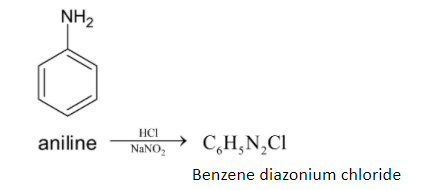Question
Question: Answer the following question: How would you convert aniline to iodobenzene?...
Answer the following question:
How would you convert aniline to iodobenzene?
Solution
Aniline has the chemical formula C6H5NH2 and iodobenzene has the chemical formula C6H5I. During the conversion of aniline to iodobenzene, there is a formation of intermediate. This can be done using two methods.
Complete step by step answer:
Aniline is an example of an aromatic amine. Amine is a compound in which an amino group is attached to the benzene ring. The structure of aniline is given below:

While iodobenzene is a compound in which an iodine atom is attached to the benzene ring. The structure of iodobenzene is given below:

The conversion of aniline to iodobenzene undergoes several steps.
First step involves the conversion of aniline to benzene diazonium chloride. This is done by dissolving aniline in dilute hydrochloric acid with an aqueous solution of sodium nitrate. Now we get benzene diazonium chloride. This reaction occurs at 273K−278K. The chemical reaction is given below:

This process is called the Sandmeyer reaction. This benzene diazonium chloride is further converted to iodobenzene.
When benzene diazonium chloride is reacted with potassium iodide, it forms iodobenzene. Potassium iodide acts as a catalyst. The reaction is given below:
C6H5N2Cl+KI→C6H5I (Iodobenzene)
Additional information:
When sodium nitrite is reacted with hydrochloric acid, nitrous acid is formed. The chemical reaction is given below:
NaNO2(Sodiumnitrite)+HCl→HONO (Nitrous acid)
When these are reacted together, two protonation steps occur and one water molecule is removed.
Note: This process of conversion of aniline to iodobenzene can also be done using Sandmeyer reaction. This reaction is the formation of aryl halides from aryl diazonium salts in the presence of some catalysts like copper salts.
